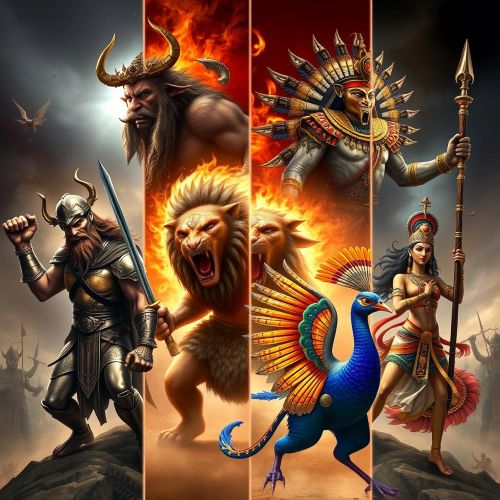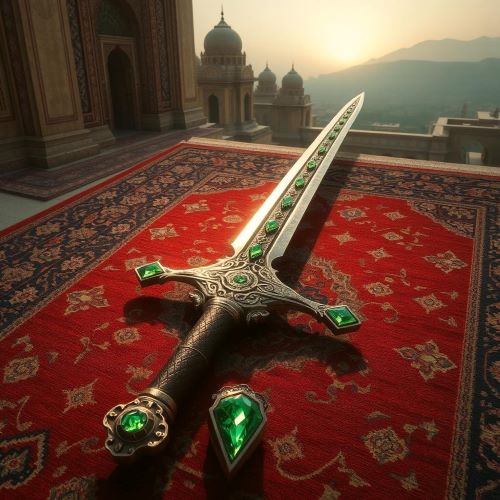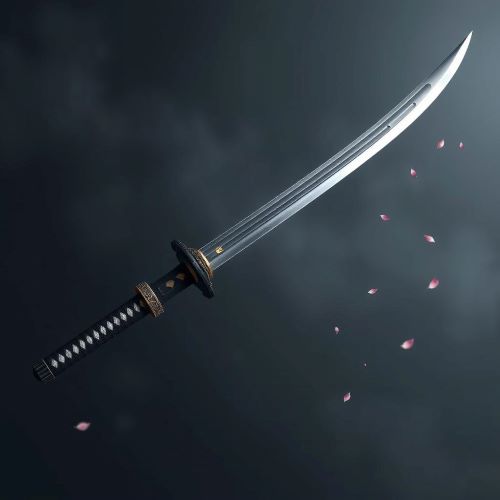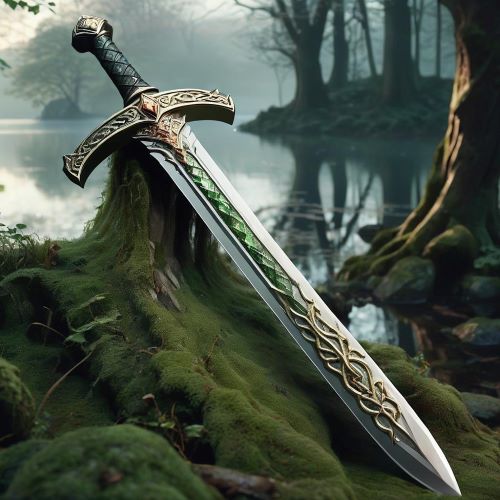Dyrnwyn : The Flaming Sword
Dyrnwyn
Introduction
Dyrnwyn, known as the “White-Hilt,” is one of the most captivating weapons in Welsh mythology. As part of the Thirteen Treasures of the Island of Britain, it represents not only immense magical strength but also profound moral weight. This is no ordinary sword—it flames only for the worthy and scorches the unworthy, acting as a mythical judge of character. Dyrnwyn’s story weaves together themes of nobility, responsibility, and selflessness, which is why it has endured through both legend and modern fantasy.
Origins
Dyrnwyn’s tale begins in the heart of Celtic tradition. Its earliest mentions come from the medieval Welsh Triads, a collection of lore and maxims preserving the oral traditions of ancient Britain. Among these legendary items, Dyrnwyn stands out for its brilliance—literally and symbolically.
Though specific details about its forging are scant, some later traditions attribute its creation to Govannon the Lame, a divine smith in Welsh myth. Crafted during an age when enchantment and morality often intertwined, Dyrnwyn was not merely a weapon of war—it was a relic imbued with a moral compass. Its ownership by King Rhydderch Hael, a figure known for unparalleled generosity, underscores its thematic alignment with virtue.
Think you know your myths and legends? Dive into the world of ancient stories and test your knowledge with our engaging quizzes on Mythlok!
Powers
The power of Dyrnwyn lies in its radiant flame, which bursts forth only when held by someone noble in spirit or high-born by blood. This is not just an offensive mechanism—it is an ordeal by fire. The sword does not grant its strength lightly. It tests, evaluates, and reveals the soul of its wielder.
This fiery enchantment doesn’t just light the battlefield—it casts illumination on the wielder’s worth. If someone lacking in integrity dares to unsheathe it, they are punished, consumed by the very flames they seek to control. This selective ignition sets Dyrnwyn apart from other mythical blades, making it a rare tool of both combat and conscience.
Modern interpretations, especially in fantasy literature and games, have expanded these magical traits. Dyrnwyn is often imagined as a weapon with divine judgment, capable of smiting evil or revealing hidden truths, staying true to its mythic origins while giving it new narrative depth.
Owners/Users
Rhydderch Hael, the 6th-century king of Alt Clut (modern Dumbarton), remains the most prominent figure linked to Dyrnwyn. Renowned for his generosity—his epithet Hael literally means “the Generous”—he would offer the sword freely to anyone who asked. Yet most rejected the gift once they learned it could ignite in flames, reflecting the idea that true power often comes with intimidating responsibility.
What makes Rhydderch’s relationship with Dyrnwyn so compelling is that he never hoarded it. He did not seek control, dominance, or fear through the blade. Instead, he viewed it as a tool to be given, even if misunderstood or feared. That alone speaks volumes about his character—and perhaps why the sword responded so powerfully in his hands.
While Rhydderch is the only historical owner recognized in the original lore, adaptations like The Chronicles of Prydain by Lloyd Alexander introduced new characters, such as Taran and Eilonwy, who interact with Dyrnwyn in ways that echo its mythic roots. These modern wielders illustrate how the sword’s test of worth remains relevant across eras.
Instances used
Unlike other legendary weapons that rack up tales of conquest, Dyrnwyn is more famous for when it wasn’t used. Its most telling episodes involve those who tried and failed to wield it. It serves more as a narrative checkpoint than a battlefield prop—its very presence shifts the dynamics of a story, even without being drawn.
Still, its symbolic use has proven deeply influential. In The Chronicles of Prydain, the sword plays a pivotal role. When Eilonwy retrieves it from a king’s barrow, it later becomes Taran’s last line of defense. Upon wielding it, he discovers that only when one’s intentions are pure can the sword be truly harnessed.
Games and pop culture have further embraced Dyrnwyn’s mystique. It appears in titles like Barony, where it retains its flaming properties and selective nature. These modern reinterpretations preserve the essence of the original myth, allowing new audiences to engage with its story in interactive ways.
Frequently Asked Questions
Lorem ipsum dolor sit amet, consectetur adipiscing?
Lorem ipsum dolor sit amet, consectetur adipiscing elit. Praesent convallis vestibulum justo, ac tincidunt nunc vehicula quis. Nullam id dolor quis orci malesuada feugiat. Curabitur aliquet libero at urna ullamcorper, ac ultricies nulla dapibus.
Lorem ipsum dolor sit amet, consectetur adipiscing?
Lorem ipsum dolor sit amet, consectetur adipiscing elit. Praesent convallis vestibulum justo, ac tincidunt nunc vehicula quis. Nullam id dolor quis orci malesuada feugiat. Curabitur aliquet libero at urna ullamcorper, ac ultricies nulla dapibus.
Lorem ipsum dolor sit amet, consectetur adipiscing?
Lorem ipsum dolor sit amet, consectetur adipiscing elit. Praesent convallis vestibulum justo, ac tincidunt nunc vehicula quis. Nullam id dolor quis orci malesuada feugiat. Curabitur aliquet libero at urna ullamcorper, ac ultricies nulla dapibus.
Lorem ipsum dolor sit amet, consectetur adipiscing?
Lorem ipsum dolor sit amet, consectetur adipiscing elit. Praesent convallis vestibulum justo, ac tincidunt nunc vehicula quis. Nullam id dolor quis orci malesuada feugiat. Curabitur aliquet libero at urna ullamcorper, ac ultricies nulla dapibus.
Lorem ipsum dolor sit amet, consectetur adipiscing?
Lorem ipsum dolor sit amet, consectetur adipiscing elit. Praesent convallis vestibulum justo, ac tincidunt nunc vehicula quis. Nullam id dolor quis orci malesuada feugiat. Curabitur aliquet libero at urna ullamcorper, ac ultricies nulla dapibus.
Watch
Source
Dyrnwyn on Toyhouse. Retrieved from https://toyhou.se/434773.dyrnwyn
Wikipedia. (None). Thirteen Treasures of the Island of Britain. Retrieved from https://en.wikipedia.org/wiki/Thirteen_Treasures_of_the_Island_of_Britain
Wikipedia. (None). Flaming sword (mythology). Retrieved from https://en.wikipedia.org/wiki/Flaming_sword_(mythology)
The Sanctuary of Sister Patience. (2017, December 25). The Sword of Rhydderch. Retrieved from https://sisterpatience.com/2017/12/25/1-the-sword-of-rhydderch/
Roman-Britain.co.uk. (None). The Thirteen Treasures of the Island of Britain. Retrieved from https://www.roman-britain.co.uk/classical-references/welsh-celtic-literature/thirteen-treasures-of-the-island-of-britain/
The Anaxverse. (2020, January 13). Dyrnwyn. Retrieved from https://www.wiki.anaxverse.com/Dyrnwyn
Prydain Wiki. (None). Dyrnwyn. Retrieved from https://prydain.fandom.com/wiki/Dyrnwyn
BaronyGame Wiki. (None). Dyrnwyn. Retrieved from https://baronygame.fandom.com/wiki/Dyrnwyn
Wikipedia. (None). List of magical weapons. Retrieved from https://en.wikipedia.com/wiki/List_of_magical_weapons
Wikipedia. (None). Rhydderch Hael. Retrieved from https://en.wikipedia.org/wiki/Rhydderch_Hael
Wix.com. (2019, July 7). The thirteen holy treasures of Britain. Retrieved from https://iffy88227.wixsite.com/sonsofbelimawr/post/the-thirteen-holy-treasures-of-prydein
Ancient Origins. (2015, April 13). The Thirteen Legendary Treasures of Britain. Retrieved from https://www.ancient-origins.net/artifacts-other-artifacts/thirteen-legendary-treasures-britain-002898







